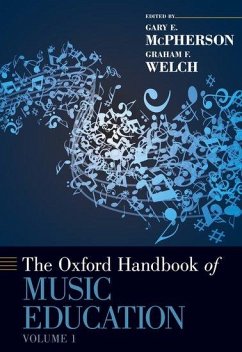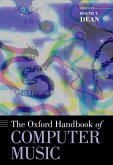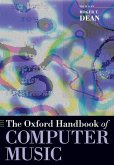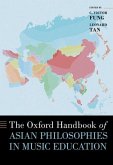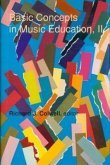Oxford Handbook of Music Education, Volume 1
Herausgegeben von McPherson, Gary E.; Welch, Graham F.
Oxford Handbook of Music Education, Volume 1
Herausgegeben von McPherson, Gary E.; Welch, Graham F.
- Gebundenes Buch
- Merkliste
- Auf die Merkliste
- Bewerten Bewerten
- Teilen
- Produkt teilen
- Produkterinnerung
- Produkterinnerung
The two volumes of The Oxford Handbook of Music Education offer a comprehensive overview of the many facets of musical experience, behavior and development in relation to the diverse variety of educational contexts in which they occur. In these volumes, an international list of contributors update and redefine the discipline through fresh and innovative principles and approaches to music learning and teaching.
Andere Kunden interessierten sich auch für
![Oxford Handbook of Computer Music Oxford Handbook of Computer Music]() Oxford Handbook of Computer Music205,99 €
Oxford Handbook of Computer Music205,99 €![Oxford Handbook of Philosophy in Music Education Oxford Handbook of Philosophy in Music Education]() Oxford Handbook of Philosophy in Music Education205,99 €
Oxford Handbook of Philosophy in Music Education205,99 €![The Oxford Handbook of Computer Music The Oxford Handbook of Computer Music]() The Oxford Handbook of Computer Music60,99 €
The Oxford Handbook of Computer Music60,99 €![The Oxford Handbook of Faust in Music The Oxford Handbook of Faust in Music]() The Oxford Handbook of Faust in Music175,99 €
The Oxford Handbook of Faust in Music175,99 €![The Oxford Handbook of Asian Philosophies in Music Education The Oxford Handbook of Asian Philosophies in Music Education]() The Oxford Handbook of Asian Philosophies in Music Education178,99 €
The Oxford Handbook of Asian Philosophies in Music Education178,99 €![Oxford Handbook of Music Censorship Oxford Handbook of Music Censorship]() Oxford Handbook of Music Censorship175,99 €
Oxford Handbook of Music Censorship175,99 €![Basic Concepts in Music Education, II Basic Concepts in Music Education, II]() Richard J. CowellBasic Concepts in Music Education, II52,99 €
Richard J. CowellBasic Concepts in Music Education, II52,99 €-
-
-
The two volumes of The Oxford Handbook of Music Education offer a comprehensive overview of the many facets of musical experience, behavior and development in relation to the diverse variety of educational contexts in which they occur. In these volumes, an international list of contributors update and redefine the discipline through fresh and innovative principles and approaches to music learning and teaching.
Produktdetails
- Produktdetails
- Oxford Handbooks in Music
- Verlag: Oxford University Press
- Seitenzahl: 992
- Erscheinungstermin: 8. August 2012
- Englisch
- Abmessung: 251mm x 176mm x 66mm
- Gewicht: 1615g
- ISBN-13: 9780199730810
- ISBN-10: 0199730814
- Artikelnr.: 35055006
- Herstellerkennzeichnung
- Libri GmbH
- Europaallee 1
- 36244 Bad Hersfeld
- gpsr@libri.de
- Oxford Handbooks in Music
- Verlag: Oxford University Press
- Seitenzahl: 992
- Erscheinungstermin: 8. August 2012
- Englisch
- Abmessung: 251mm x 176mm x 66mm
- Gewicht: 1615g
- ISBN-13: 9780199730810
- ISBN-10: 0199730814
- Artikelnr.: 35055006
- Herstellerkennzeichnung
- Libri GmbH
- Europaallee 1
- 36244 Bad Hersfeld
- gpsr@libri.de
Gary E. McPherson is Ormond Chair and Director of the Melbourne Conservatorium of Music, University of Melbourne. He is editor of The Science and Psychology of Music Performance (OUP, 2002, with Richard Parncutt) and The Child as Musician: A Handbook of Musical Development (2006). Graham Welch is Chair of Music Education at the Institute of Education, University of London and Deputy Dean of the Institute's Faculty of Culture and Pedagogy. He is elected Chair of the internationally based Society for Education, Music and Psychology Research (SEMPRE) and President of the International Society for Music Education (ISME). His publications number over two hundred and embrace musical development and music education, teacher education, the psychology of music, singing and voice science and music in special education and disability.
* Handbook Preface
* Acknowledgments
* External referees
* Section 1: Music education and the role of music in people's lives
* Section Editor: Graham F. Welch and Gary E. McPherson
* Chapter 1: introduction and commentary: Music education and the role
of music in people's lives
* Graham F. Welch and Gary E. McPherson
* Chapter 2: Music's place in education
* Wayne Bowman
* Chapter 3: International perspectives
* Marie McCarthy
* Chapter 4: A philosophy of music education
* David J. Elliott
* Chapter 5: Cultural diversity: Beyond 'songs from every land'
* Huib Schippers and Patricia Shehan Campbell
* Chapter 6: Some contributions of ethnomusicology
* Bruno Nettl
* Chapter 7: Musical identities mediate musical development
* David J. Hargreaves, Raymond MacDonald and Dorothy Miell
* Chapter 8: Supporting motivation in music education
* Authors: James M. Renwick and Johnmarshall Reeve
* Chapter 9: Becoming a music learner: Towards a theory of
transformative music engagement
* Susan A. O'Neill
* Chapter 10: Initiating music programs in new contexts: In search of a
democratic music education
* Graça Mota and Sérgio Figueiredo
* Chapter 11: Implications of neurosciences and brain research for
music teaching and learning
* Donald Hodges and Wilfried Gruhn
* Section 2: Music learning and teaching in infancy and early childhood
* Section Editor: Margaret Barrett
* Chapter 12: Commentary: Music learning and teaching in infancy and
early childhood
* Margaret S. Barrett
* Chapter 13: Musical lives of infants
* Mayumi Adachi (Japan) and Sandra E. Trehub
* Chapter 14: Musicality and musical culture: Sharing narratives of
sound from early childhood
* Colwyn Trevarthen and Stephen Malloch
* Chapter 15: Music and language in early childhood development and
learning
* Lily Chen-Hafteck and Esther Mang
* Chapter 16: Musical participation from birth to three: Towards a
global perspective
* Susan Young and Beatriz Ilari
* Chapter 16: Creative meaning-making in infants' and young children's
musical cultures
* Margaret S. Barrett and Johannella Tafuri
* Section 3: Music learning and teaching during childhood: Ages 5-12
* Section Editor: Kathryn Marsh
* Chapter 17: Commentary: Music learning and teaching during childhood:
Ages 5-12
* Kathryn Marsh
* Chapter 18: Children's ways of learning inside and outside the
classroom
* Eve Harwood and Kathryn Marsh
* Chapter 19: Creating in music learning contexts
* Jackie Wiggins and Magne Espeland
* Chapter 20: Meaningful connections in a comprehensive approach to the
music curriculum
* Janet R. Barrett and Kari K. Veblen
* Chapter 21: Multiple worlds of childhood: Culture and the classroom
* Chee-Hoo Lum and Kathryn Marsh
* Chapter 22: Music education in the generalist classroom
* Neryl Jeanneret and George DeGraffenreid
* Chapter 23: Instrumental ensemble learning and performance in primary
school
* Sharon G. Davis (USA)
* Section 4: Music learning and teaching during adolescence: Ages 12-18
* Section Editor: Oscar Odena and Gary Spruce
* Chapter 24: Commentary: Music learning and teaching during
adolescence: Ages 12-18
* Gary Spruce and Oscar Odena
* Chapter 25: Teaching, learning and curriculum content
* Chris Philpott and Ruth Wright
* Chapter 26: Youth culture and secondary education
* Randall Everett Allsup, Heidi Westerlund and Eric Shieh
* Chapter 27: Assessment in the secondary music classroom
* Martin Fautley and Richard Colwell
* Chapter 28: The community music facilitator and school music
education
* Lee Higgins and Brydie-Leigh Bartleet
* Chapter 29: Creativity in the secondary music classroom
* Oscar Odena
* Chapter 30: Technology in the lives and schools of adolescents
* S. Alex Ruthmann and Steven C. Dillon
* Section 5: Vocal and Choral Music
* Section Editor: John Nix
* Chapter 31: Commentary: Vocal and choral music
* John Nix
* Chapter 32: Solo voice pedagogy
* Jean Callaghan, Shirlee Emmons and Lisa Popeil
* Chapter 33: Group and ensemble vocal music
* Sten Ternström, Harald Jers and John Nix
* Chapter 34: The young singer
* Ken Phillips , Jenevora Williams and Robert Edwin
* Chapter 35: The older singer
* Robert T. Sataloff and Jane Davidson
* Chapter 36: Voice health and vocal education
* John Nix and Nelson Roy
* Section 6: Instrumental Music
* Section Editor - Susan Hallam
* Chapter 37: Commentary: Instrumental music
* Susan Hallam
* Chapter 38: Processes of instrumental learning: The development of
musical expertise
* Susan Hallam and Alfredo Bautista
* Chapter 39: Practice
* Andreas C. Lehmann and Harald Jorgensen
* Chapter 40: The changing face of individual instrumental tuition:
Value, purpose and potential
* Andrea Creech and Helena Gaunt
* Chapter 41: Building musicianship in the instrumental classroom
* Robert A. Duke and James L. Byo
* Chapter 42: Psychological and physiological aspects of learning to
perform
* Ioulia Papageorgi and Reinhard Kopiez
* Chapter 43: Musical instrument learning, music ensembles, and
musicianship in a global and digital age
* Frederick Seddon and Michael Webb
* Chapter 44: The role of bodily movement in learning and performing
music: Applications for education
* Jane Davidson
* Section 7: Ensembles
* Section Editor - Jere T. Humphreys
* Chapter 45: Commentary: Ensembles
* Jere T. Humphreys
* Chapter 46: The sociology and policy of ensembles
* John W. Richmond
* Chapter 47: North American school ensembles
* William R. Lee with Michael D. Worthy
* Chapter 48: Once from the top: Reframing the role of the conductor in
ensemble teaching
* Steven J. Morrison and Steven M. Demorest
* Chapter 49: Community music ensembles
* Don Coffman and Lee Higgins
* Chapter 50: Youth orchestras
* Margaret Kartomi
* Chapter 51: Popular music ensembles
* Carlos Xavier Rodriguez
* Chapter 52: Pathways to learning and teaching Indigenous and World
Music ensembles
* Robert Burke and Sam Evans
* Acknowledgments
* External referees
* Section 1: Music education and the role of music in people's lives
* Section Editor: Graham F. Welch and Gary E. McPherson
* Chapter 1: introduction and commentary: Music education and the role
of music in people's lives
* Graham F. Welch and Gary E. McPherson
* Chapter 2: Music's place in education
* Wayne Bowman
* Chapter 3: International perspectives
* Marie McCarthy
* Chapter 4: A philosophy of music education
* David J. Elliott
* Chapter 5: Cultural diversity: Beyond 'songs from every land'
* Huib Schippers and Patricia Shehan Campbell
* Chapter 6: Some contributions of ethnomusicology
* Bruno Nettl
* Chapter 7: Musical identities mediate musical development
* David J. Hargreaves, Raymond MacDonald and Dorothy Miell
* Chapter 8: Supporting motivation in music education
* Authors: James M. Renwick and Johnmarshall Reeve
* Chapter 9: Becoming a music learner: Towards a theory of
transformative music engagement
* Susan A. O'Neill
* Chapter 10: Initiating music programs in new contexts: In search of a
democratic music education
* Graça Mota and Sérgio Figueiredo
* Chapter 11: Implications of neurosciences and brain research for
music teaching and learning
* Donald Hodges and Wilfried Gruhn
* Section 2: Music learning and teaching in infancy and early childhood
* Section Editor: Margaret Barrett
* Chapter 12: Commentary: Music learning and teaching in infancy and
early childhood
* Margaret S. Barrett
* Chapter 13: Musical lives of infants
* Mayumi Adachi (Japan) and Sandra E. Trehub
* Chapter 14: Musicality and musical culture: Sharing narratives of
sound from early childhood
* Colwyn Trevarthen and Stephen Malloch
* Chapter 15: Music and language in early childhood development and
learning
* Lily Chen-Hafteck and Esther Mang
* Chapter 16: Musical participation from birth to three: Towards a
global perspective
* Susan Young and Beatriz Ilari
* Chapter 16: Creative meaning-making in infants' and young children's
musical cultures
* Margaret S. Barrett and Johannella Tafuri
* Section 3: Music learning and teaching during childhood: Ages 5-12
* Section Editor: Kathryn Marsh
* Chapter 17: Commentary: Music learning and teaching during childhood:
Ages 5-12
* Kathryn Marsh
* Chapter 18: Children's ways of learning inside and outside the
classroom
* Eve Harwood and Kathryn Marsh
* Chapter 19: Creating in music learning contexts
* Jackie Wiggins and Magne Espeland
* Chapter 20: Meaningful connections in a comprehensive approach to the
music curriculum
* Janet R. Barrett and Kari K. Veblen
* Chapter 21: Multiple worlds of childhood: Culture and the classroom
* Chee-Hoo Lum and Kathryn Marsh
* Chapter 22: Music education in the generalist classroom
* Neryl Jeanneret and George DeGraffenreid
* Chapter 23: Instrumental ensemble learning and performance in primary
school
* Sharon G. Davis (USA)
* Section 4: Music learning and teaching during adolescence: Ages 12-18
* Section Editor: Oscar Odena and Gary Spruce
* Chapter 24: Commentary: Music learning and teaching during
adolescence: Ages 12-18
* Gary Spruce and Oscar Odena
* Chapter 25: Teaching, learning and curriculum content
* Chris Philpott and Ruth Wright
* Chapter 26: Youth culture and secondary education
* Randall Everett Allsup, Heidi Westerlund and Eric Shieh
* Chapter 27: Assessment in the secondary music classroom
* Martin Fautley and Richard Colwell
* Chapter 28: The community music facilitator and school music
education
* Lee Higgins and Brydie-Leigh Bartleet
* Chapter 29: Creativity in the secondary music classroom
* Oscar Odena
* Chapter 30: Technology in the lives and schools of adolescents
* S. Alex Ruthmann and Steven C. Dillon
* Section 5: Vocal and Choral Music
* Section Editor: John Nix
* Chapter 31: Commentary: Vocal and choral music
* John Nix
* Chapter 32: Solo voice pedagogy
* Jean Callaghan, Shirlee Emmons and Lisa Popeil
* Chapter 33: Group and ensemble vocal music
* Sten Ternström, Harald Jers and John Nix
* Chapter 34: The young singer
* Ken Phillips , Jenevora Williams and Robert Edwin
* Chapter 35: The older singer
* Robert T. Sataloff and Jane Davidson
* Chapter 36: Voice health and vocal education
* John Nix and Nelson Roy
* Section 6: Instrumental Music
* Section Editor - Susan Hallam
* Chapter 37: Commentary: Instrumental music
* Susan Hallam
* Chapter 38: Processes of instrumental learning: The development of
musical expertise
* Susan Hallam and Alfredo Bautista
* Chapter 39: Practice
* Andreas C. Lehmann and Harald Jorgensen
* Chapter 40: The changing face of individual instrumental tuition:
Value, purpose and potential
* Andrea Creech and Helena Gaunt
* Chapter 41: Building musicianship in the instrumental classroom
* Robert A. Duke and James L. Byo
* Chapter 42: Psychological and physiological aspects of learning to
perform
* Ioulia Papageorgi and Reinhard Kopiez
* Chapter 43: Musical instrument learning, music ensembles, and
musicianship in a global and digital age
* Frederick Seddon and Michael Webb
* Chapter 44: The role of bodily movement in learning and performing
music: Applications for education
* Jane Davidson
* Section 7: Ensembles
* Section Editor - Jere T. Humphreys
* Chapter 45: Commentary: Ensembles
* Jere T. Humphreys
* Chapter 46: The sociology and policy of ensembles
* John W. Richmond
* Chapter 47: North American school ensembles
* William R. Lee with Michael D. Worthy
* Chapter 48: Once from the top: Reframing the role of the conductor in
ensemble teaching
* Steven J. Morrison and Steven M. Demorest
* Chapter 49: Community music ensembles
* Don Coffman and Lee Higgins
* Chapter 50: Youth orchestras
* Margaret Kartomi
* Chapter 51: Popular music ensembles
* Carlos Xavier Rodriguez
* Chapter 52: Pathways to learning and teaching Indigenous and World
Music ensembles
* Robert Burke and Sam Evans
* Handbook Preface
* Acknowledgments
* External referees
* Section 1: Music education and the role of music in people's lives
* Section Editor: Graham F. Welch and Gary E. McPherson
* Chapter 1: introduction and commentary: Music education and the role
of music in people's lives
* Graham F. Welch and Gary E. McPherson
* Chapter 2: Music's place in education
* Wayne Bowman
* Chapter 3: International perspectives
* Marie McCarthy
* Chapter 4: A philosophy of music education
* David J. Elliott
* Chapter 5: Cultural diversity: Beyond 'songs from every land'
* Huib Schippers and Patricia Shehan Campbell
* Chapter 6: Some contributions of ethnomusicology
* Bruno Nettl
* Chapter 7: Musical identities mediate musical development
* David J. Hargreaves, Raymond MacDonald and Dorothy Miell
* Chapter 8: Supporting motivation in music education
* Authors: James M. Renwick and Johnmarshall Reeve
* Chapter 9: Becoming a music learner: Towards a theory of
transformative music engagement
* Susan A. O'Neill
* Chapter 10: Initiating music programs in new contexts: In search of a
democratic music education
* Graça Mota and Sérgio Figueiredo
* Chapter 11: Implications of neurosciences and brain research for
music teaching and learning
* Donald Hodges and Wilfried Gruhn
* Section 2: Music learning and teaching in infancy and early childhood
* Section Editor: Margaret Barrett
* Chapter 12: Commentary: Music learning and teaching in infancy and
early childhood
* Margaret S. Barrett
* Chapter 13: Musical lives of infants
* Mayumi Adachi (Japan) and Sandra E. Trehub
* Chapter 14: Musicality and musical culture: Sharing narratives of
sound from early childhood
* Colwyn Trevarthen and Stephen Malloch
* Chapter 15: Music and language in early childhood development and
learning
* Lily Chen-Hafteck and Esther Mang
* Chapter 16: Musical participation from birth to three: Towards a
global perspective
* Susan Young and Beatriz Ilari
* Chapter 16: Creative meaning-making in infants' and young children's
musical cultures
* Margaret S. Barrett and Johannella Tafuri
* Section 3: Music learning and teaching during childhood: Ages 5-12
* Section Editor: Kathryn Marsh
* Chapter 17: Commentary: Music learning and teaching during childhood:
Ages 5-12
* Kathryn Marsh
* Chapter 18: Children's ways of learning inside and outside the
classroom
* Eve Harwood and Kathryn Marsh
* Chapter 19: Creating in music learning contexts
* Jackie Wiggins and Magne Espeland
* Chapter 20: Meaningful connections in a comprehensive approach to the
music curriculum
* Janet R. Barrett and Kari K. Veblen
* Chapter 21: Multiple worlds of childhood: Culture and the classroom
* Chee-Hoo Lum and Kathryn Marsh
* Chapter 22: Music education in the generalist classroom
* Neryl Jeanneret and George DeGraffenreid
* Chapter 23: Instrumental ensemble learning and performance in primary
school
* Sharon G. Davis (USA)
* Section 4: Music learning and teaching during adolescence: Ages 12-18
* Section Editor: Oscar Odena and Gary Spruce
* Chapter 24: Commentary: Music learning and teaching during
adolescence: Ages 12-18
* Gary Spruce and Oscar Odena
* Chapter 25: Teaching, learning and curriculum content
* Chris Philpott and Ruth Wright
* Chapter 26: Youth culture and secondary education
* Randall Everett Allsup, Heidi Westerlund and Eric Shieh
* Chapter 27: Assessment in the secondary music classroom
* Martin Fautley and Richard Colwell
* Chapter 28: The community music facilitator and school music
education
* Lee Higgins and Brydie-Leigh Bartleet
* Chapter 29: Creativity in the secondary music classroom
* Oscar Odena
* Chapter 30: Technology in the lives and schools of adolescents
* S. Alex Ruthmann and Steven C. Dillon
* Section 5: Vocal and Choral Music
* Section Editor: John Nix
* Chapter 31: Commentary: Vocal and choral music
* John Nix
* Chapter 32: Solo voice pedagogy
* Jean Callaghan, Shirlee Emmons and Lisa Popeil
* Chapter 33: Group and ensemble vocal music
* Sten Ternström, Harald Jers and John Nix
* Chapter 34: The young singer
* Ken Phillips , Jenevora Williams and Robert Edwin
* Chapter 35: The older singer
* Robert T. Sataloff and Jane Davidson
* Chapter 36: Voice health and vocal education
* John Nix and Nelson Roy
* Section 6: Instrumental Music
* Section Editor - Susan Hallam
* Chapter 37: Commentary: Instrumental music
* Susan Hallam
* Chapter 38: Processes of instrumental learning: The development of
musical expertise
* Susan Hallam and Alfredo Bautista
* Chapter 39: Practice
* Andreas C. Lehmann and Harald Jorgensen
* Chapter 40: The changing face of individual instrumental tuition:
Value, purpose and potential
* Andrea Creech and Helena Gaunt
* Chapter 41: Building musicianship in the instrumental classroom
* Robert A. Duke and James L. Byo
* Chapter 42: Psychological and physiological aspects of learning to
perform
* Ioulia Papageorgi and Reinhard Kopiez
* Chapter 43: Musical instrument learning, music ensembles, and
musicianship in a global and digital age
* Frederick Seddon and Michael Webb
* Chapter 44: The role of bodily movement in learning and performing
music: Applications for education
* Jane Davidson
* Section 7: Ensembles
* Section Editor - Jere T. Humphreys
* Chapter 45: Commentary: Ensembles
* Jere T. Humphreys
* Chapter 46: The sociology and policy of ensembles
* John W. Richmond
* Chapter 47: North American school ensembles
* William R. Lee with Michael D. Worthy
* Chapter 48: Once from the top: Reframing the role of the conductor in
ensemble teaching
* Steven J. Morrison and Steven M. Demorest
* Chapter 49: Community music ensembles
* Don Coffman and Lee Higgins
* Chapter 50: Youth orchestras
* Margaret Kartomi
* Chapter 51: Popular music ensembles
* Carlos Xavier Rodriguez
* Chapter 52: Pathways to learning and teaching Indigenous and World
Music ensembles
* Robert Burke and Sam Evans
* Acknowledgments
* External referees
* Section 1: Music education and the role of music in people's lives
* Section Editor: Graham F. Welch and Gary E. McPherson
* Chapter 1: introduction and commentary: Music education and the role
of music in people's lives
* Graham F. Welch and Gary E. McPherson
* Chapter 2: Music's place in education
* Wayne Bowman
* Chapter 3: International perspectives
* Marie McCarthy
* Chapter 4: A philosophy of music education
* David J. Elliott
* Chapter 5: Cultural diversity: Beyond 'songs from every land'
* Huib Schippers and Patricia Shehan Campbell
* Chapter 6: Some contributions of ethnomusicology
* Bruno Nettl
* Chapter 7: Musical identities mediate musical development
* David J. Hargreaves, Raymond MacDonald and Dorothy Miell
* Chapter 8: Supporting motivation in music education
* Authors: James M. Renwick and Johnmarshall Reeve
* Chapter 9: Becoming a music learner: Towards a theory of
transformative music engagement
* Susan A. O'Neill
* Chapter 10: Initiating music programs in new contexts: In search of a
democratic music education
* Graça Mota and Sérgio Figueiredo
* Chapter 11: Implications of neurosciences and brain research for
music teaching and learning
* Donald Hodges and Wilfried Gruhn
* Section 2: Music learning and teaching in infancy and early childhood
* Section Editor: Margaret Barrett
* Chapter 12: Commentary: Music learning and teaching in infancy and
early childhood
* Margaret S. Barrett
* Chapter 13: Musical lives of infants
* Mayumi Adachi (Japan) and Sandra E. Trehub
* Chapter 14: Musicality and musical culture: Sharing narratives of
sound from early childhood
* Colwyn Trevarthen and Stephen Malloch
* Chapter 15: Music and language in early childhood development and
learning
* Lily Chen-Hafteck and Esther Mang
* Chapter 16: Musical participation from birth to three: Towards a
global perspective
* Susan Young and Beatriz Ilari
* Chapter 16: Creative meaning-making in infants' and young children's
musical cultures
* Margaret S. Barrett and Johannella Tafuri
* Section 3: Music learning and teaching during childhood: Ages 5-12
* Section Editor: Kathryn Marsh
* Chapter 17: Commentary: Music learning and teaching during childhood:
Ages 5-12
* Kathryn Marsh
* Chapter 18: Children's ways of learning inside and outside the
classroom
* Eve Harwood and Kathryn Marsh
* Chapter 19: Creating in music learning contexts
* Jackie Wiggins and Magne Espeland
* Chapter 20: Meaningful connections in a comprehensive approach to the
music curriculum
* Janet R. Barrett and Kari K. Veblen
* Chapter 21: Multiple worlds of childhood: Culture and the classroom
* Chee-Hoo Lum and Kathryn Marsh
* Chapter 22: Music education in the generalist classroom
* Neryl Jeanneret and George DeGraffenreid
* Chapter 23: Instrumental ensemble learning and performance in primary
school
* Sharon G. Davis (USA)
* Section 4: Music learning and teaching during adolescence: Ages 12-18
* Section Editor: Oscar Odena and Gary Spruce
* Chapter 24: Commentary: Music learning and teaching during
adolescence: Ages 12-18
* Gary Spruce and Oscar Odena
* Chapter 25: Teaching, learning and curriculum content
* Chris Philpott and Ruth Wright
* Chapter 26: Youth culture and secondary education
* Randall Everett Allsup, Heidi Westerlund and Eric Shieh
* Chapter 27: Assessment in the secondary music classroom
* Martin Fautley and Richard Colwell
* Chapter 28: The community music facilitator and school music
education
* Lee Higgins and Brydie-Leigh Bartleet
* Chapter 29: Creativity in the secondary music classroom
* Oscar Odena
* Chapter 30: Technology in the lives and schools of adolescents
* S. Alex Ruthmann and Steven C. Dillon
* Section 5: Vocal and Choral Music
* Section Editor: John Nix
* Chapter 31: Commentary: Vocal and choral music
* John Nix
* Chapter 32: Solo voice pedagogy
* Jean Callaghan, Shirlee Emmons and Lisa Popeil
* Chapter 33: Group and ensemble vocal music
* Sten Ternström, Harald Jers and John Nix
* Chapter 34: The young singer
* Ken Phillips , Jenevora Williams and Robert Edwin
* Chapter 35: The older singer
* Robert T. Sataloff and Jane Davidson
* Chapter 36: Voice health and vocal education
* John Nix and Nelson Roy
* Section 6: Instrumental Music
* Section Editor - Susan Hallam
* Chapter 37: Commentary: Instrumental music
* Susan Hallam
* Chapter 38: Processes of instrumental learning: The development of
musical expertise
* Susan Hallam and Alfredo Bautista
* Chapter 39: Practice
* Andreas C. Lehmann and Harald Jorgensen
* Chapter 40: The changing face of individual instrumental tuition:
Value, purpose and potential
* Andrea Creech and Helena Gaunt
* Chapter 41: Building musicianship in the instrumental classroom
* Robert A. Duke and James L. Byo
* Chapter 42: Psychological and physiological aspects of learning to
perform
* Ioulia Papageorgi and Reinhard Kopiez
* Chapter 43: Musical instrument learning, music ensembles, and
musicianship in a global and digital age
* Frederick Seddon and Michael Webb
* Chapter 44: The role of bodily movement in learning and performing
music: Applications for education
* Jane Davidson
* Section 7: Ensembles
* Section Editor - Jere T. Humphreys
* Chapter 45: Commentary: Ensembles
* Jere T. Humphreys
* Chapter 46: The sociology and policy of ensembles
* John W. Richmond
* Chapter 47: North American school ensembles
* William R. Lee with Michael D. Worthy
* Chapter 48: Once from the top: Reframing the role of the conductor in
ensemble teaching
* Steven J. Morrison and Steven M. Demorest
* Chapter 49: Community music ensembles
* Don Coffman and Lee Higgins
* Chapter 50: Youth orchestras
* Margaret Kartomi
* Chapter 51: Popular music ensembles
* Carlos Xavier Rodriguez
* Chapter 52: Pathways to learning and teaching Indigenous and World
Music ensembles
* Robert Burke and Sam Evans

